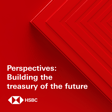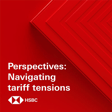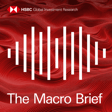Become a Creator today!Start creating today - Share your story with the world!
Start for free
00:00:00
00:00:01

India’s COVID-19 crisis, Europe update, China’s growth surge - HSBC Global Research
Pranjul Bhandari assesses India’s rapidly deteriorating COVID-19 picture, Simon Wells talks through the key takeaways from the ECB’s latest meeting and Qu Hongbin explains why we do not believe the Chinese economy is running above its speed limit. Disclaimer.
To stay connected and to access free to view reports and videos from HSBC Global Research click here.
Hosted on Acast. See acast.com/privacy for more information.
Transcript
Introduction to HSBC Global and Macro Viewpoint
00:00:00
Speaker
This is HSBC Global Viewpoint, your window into the thinking, trends and issues shaping global banking and markets.
00:00:09
Speaker
Join us as we hear from industry leaders and HSBC experts on the latest insights and opportunities for your business.
00:00:17
Speaker
Thank you for listening.
00:00:23
Speaker
Hello and welcome to the Macro Viewpoint from HSBC Global Research, our weekly podcast featuring the views of leading HSBC analysts on the outlook for the global economy and markets.
00:00:32
Speaker
I'm Piers Butler.
00:00:34
Speaker
And I'm Chris Brown-Hulmes.
India's COVID-19 Crisis: Economic Impacts and Responses
00:00:35
Speaker
Coming up on this week's podcast, India's COVID-19 situation is raging out of control, with new cases skyrocketing over recent weeks.
00:00:43
Speaker
We get the latest and what it means for the economic recovery from Pranjal Bhandari, Chief India Economist.
00:00:49
Speaker
COVID-19 cases also remain elevated across much of Europe.
00:00:53
Speaker
Simon Wells, Chief European Economist, brings us up to date on that and the key takeaways from the latest ECB meeting.
00:01:01
Speaker
And with a strong headline GDP growth, is China's economy in danger of overheating?
00:01:06
Speaker
We get the thoughts of Xu Hongbin, Chief China Economist.
00:01:10
Speaker
This podcast was recorded on Thursday, the 22nd of April 2021.
00:01:13
Speaker
Our full disclosures and disclaimers can be found in the link attached to this podcast.
00:01:21
Speaker
We start this week in India, where the COVID-19 picture has deteriorated rapidly.
00:01:27
Speaker
New cases have picked up dramatically during April, with the country hitting a global daily record of 315,000 new cases today.
00:01:36
Speaker
For more on this and the implications on the economy, let's speak to Pranjal Bhandari, Chief India Economist.
00:01:42
Speaker
Pranjal, welcome to the podcast.
00:01:43
Speaker
Great to be here, Piers.
00:01:45
Speaker
So every day we're getting new headlines in the press about the worsening situation for COVID-19 infections in India.
00:01:51
Speaker
At the start of the year, India seemed to be in great shape.
00:01:53
Speaker
So what happened and what's the latest data?
00:01:56
Speaker
Yes, yes, Piers.
00:01:58
Speaker
You know, this is a very infectious second wave that has sprung out of nowhere.
00:02:03
Speaker
It's a new strain that is spreading like wildfire across the country.
00:02:07
Speaker
Just to give you some numbers, you know, India is seeing about 300,000 new cases per day.
00:02:13
Speaker
And last year in the first wave, at peak, it was about 97,000 new cases.
00:02:20
Speaker
The mortality rate remains low.
00:02:22
Speaker
But just the sheer number of fatalities that we're seeing per day has risen sharply.
00:02:28
Speaker
And the health infrastructure is quite overwhelmed.
00:02:31
Speaker
There are shortages of beds, medicines and oxygen.
00:02:34
Speaker
Could an acceleration in the vaccine program that's underway make a difference?
00:02:37
Speaker
Yes, I think so.
00:02:38
Speaker
I think vaccines are probably the best stimulus that can be given to the economy right now.
00:02:44
Speaker
But the vaccination rate currently is about 3 million jabs a day.
00:02:49
Speaker
And only those who are over the age of 45 years are eligible.
00:02:53
Speaker
But this criteria is being widened.
00:02:55
Speaker
Starting from 1st May, all people over the age of 18 years will be able to get a vaccine.
00:03:01
Speaker
We're also expecting that there will be an increase in the supply of vaccines around the middle of the year.
00:03:07
Speaker
So if we bring all of this together and if the vaccination rate rises from 3 million doses per day now to about 5 million doses by August, it could cover about 50 percent of the population by the end of the calendar year.
00:03:20
Speaker
So all of this is likely to have an economic impact.
00:03:23
Speaker
How has it affected your outlook for the economy?
00:03:26
Speaker
Yes, for sure.
00:03:27
Speaker
You know, many local lockdowns are back in play.
00:03:30
Speaker
Maharashtra announced a 15-day complete lockdown.
00:03:33
Speaker
Delhi followed up by announcing a six-day full lockdown.
00:03:37
Speaker
The growth cost of just these two could be 1% of the country's GDP in the June quarter and could actually rise further.
00:03:45
Speaker
if other states also replicate these lockdowns.
00:03:49
Speaker
We also have a recovery tracker, which has already fallen 10 percentage points from the February highs.
00:03:55
Speaker
Unemployment rates have begun to rise, particularly in urban India.
00:03:59
Speaker
High touch services have been impacted.
00:04:01
Speaker
Electricity consumption, which is generally the more resilient part of the economy, has also begun to fall.
00:04:07
Speaker
In fact, we think this is going to impact GDP numbers.
00:04:10
Speaker
We're expecting a negative year-on-year GDP growth print in March and a negative quarter-on-quarter print in the quarter ending June.
00:04:19
Speaker
I also think this will have implications for monetary policy and fiscal policy.
00:04:23
Speaker
It is likely to delay the exit of the central bank from very loose monetary policy.
00:04:29
Speaker
We now expect that the central bank will start on its gradual exit
00:04:33
Speaker
Only in the fourth quarter of the year, when vaccination reaches critical mass, you know, earlier we were expecting that the exit would begin in the middle of 2021.
00:04:41
Speaker
In terms of fiscal finances, I think there are going to be some new challenges that come up.
00:04:46
Speaker
For instance, demand for more social welfare schemes, weaker tax revenues, and uncertainties around asset seals.
00:04:53
Speaker
So I think all parts of the economy are going to get impacted.
00:04:56
Speaker
Pranjal, thank you very much for joining us.
00:04:58
Speaker
Great to be here.
Europe's COVID-19 Situation and Economic Measures
00:05:02
Speaker
So let's get the latest now on the COVID situation here in Europe, where cases remain elevated.
00:05:07
Speaker
And we'll get an update on the outcome of the latest ECB meeting.
00:05:10
Speaker
Simon Wells, Chief European Economist, joins us to discuss both these topics.
00:05:15
Speaker
So Simon, we've just been hearing there about the alarming COVID situation in India.
00:05:20
Speaker
What is the latest in Europe?
00:05:22
Speaker
Well, in Europe, Chris, the news is slightly better in that case numbers are now largely stable.
00:05:31
Speaker
There are still some rising hospital admissions in Germany and they're creeping up in France.
00:05:36
Speaker
But generally, I think we're seeing now a stabilisation in case numbers as a result of the lockdowns.
00:05:44
Speaker
And we're also seeing in the EU a big step up in the pace of vaccination.
00:05:50
Speaker
The EU wants to vaccinate 70% of the population by the end of the summer.
00:05:56
Speaker
And a few months ago, that was looking very challenging indeed.
00:06:00
Speaker
There's still work to be done in terms of increasing the pace further, but it doesn't look quite as unrealistic as it once did.
00:06:07
Speaker
And in that sense, that is also good news.
00:06:09
Speaker
Meanwhile, this continues to cost governments quite a lot of money and it's pushing up budget deficits.
00:06:15
Speaker
That's right.
00:06:15
Speaker
I mean, we've also seen, I guess, some favourable news on the fiscal side, too.
00:06:20
Speaker
So a new 40 billion euro stimulus package has been announced in Italy, for example.
00:06:27
Speaker
That means its deficit target for this year has been raised from 7% of GDP per
00:06:34
Speaker
to 11.8% of GDP.
00:06:38
Speaker
That means it will have one of the highest deficits in the eurozone this year.
00:06:43
Speaker
But it does mean that governments are ramping up the response.
00:06:48
Speaker
And importantly, we've had a ruling from the German Constitutional Court, which has ruled that the German government can sign up to the EU's 750 billion euro recovery fund,
00:07:02
Speaker
which is good news.
00:07:03
Speaker
It removes one risk of delay.
00:07:06
Speaker
But the court also reminded us that to be legal, any recovery fund has to be limited in scope and limited in time.
00:07:15
Speaker
And it did leave the door open to overturning this ruling once it's had time.
00:07:20
Speaker
time to take a more considered judgment.
00:07:23
Speaker
But in terms of removing risks of further delays, that was also a positive step on the fiscal front.
European Central Bank's Monetary Policy Outlook
00:07:30
Speaker
So you mentioned the fiscal issues there.
00:07:32
Speaker
Turning to the monetary side, we've just had an ECB meeting today.
00:07:37
Speaker
Have we learned anything new?
00:07:39
Speaker
Well, not much, to be honest.
00:07:40
Speaker
It wasn't a particularly exciting meeting.
00:07:43
Speaker
There were no changes in policy, no changes in the statement, with the ECB simply reiterating from the last meeting that it intends to significantly increase the purchase pace of bonds under its pandemic emergency purchase programme.
00:08:04
Speaker
So in that sense, it was just reiterating the previous meeting
00:08:07
Speaker
However, further ahead, it is going still to face some challenges.
00:08:12
Speaker
It was questioned a lot at the press conference on its communications.
00:08:17
Speaker
We think that to avoid a cliff edge in central bank bond buying when that pandemic emergency purchase programme is scheduled to end next March,
00:08:28
Speaker
It will probably need to do some more loosening and we think it will revert back to its normal programme of bond buying, the so-called asset purchase programme.
00:08:38
Speaker
And so it might soften the impact of the end of PEP with an announcement at some point this year.
00:08:45
Speaker
But the April meeting itself was no great shakes.
00:08:49
Speaker
Simon, thanks very much for your comments today.
00:08:51
Speaker
Thank you.
China's Economic Recovery and Growth Strategies
00:08:55
Speaker
One economy that is firing on all cylinders is China.
00:08:59
Speaker
Growth recovered to pre-pandemic levels at the end of 2020, leading some commentators to ask whether the economy runs the risk of overheating.
00:09:07
Speaker
Let's hear from Chu Hongbin, chief China economist.
00:09:11
Speaker
So Hongbin, could China's economy overheat in the coming years?
00:09:14
Speaker
As we all know, the Chinese economy has been rebounded very, very strongly, particularly in the first quarter of this year.
00:09:23
Speaker
partly because the low base effect, we have something like above 18% year on year GDP growth rate.
00:09:29
Speaker
But I have to say that a significant part of that is coming from the low base effect.
00:09:34
Speaker
If you strip off the low base effect, the underlying growth rate is probably something around five to 6%, which is still below the pre-pandemic level and also below the potential growth rate.
00:09:50
Speaker
the risk for economy to overheat, in our view, will be limited.
00:09:56
Speaker
So what is China's potential growth rate, do you think?
00:09:59
Speaker
The consensus view seems to suggest that China's potential growth rate has been slowing quite fast in recent years and is heading towards around 5% in the coming years, mainly due to the shrinking labour force and the rising debt burden.
00:10:17
Speaker
And we disagree.
00:10:19
Speaker
we believe that the potential growth rate for China is still going to remain above 6.5% in the coming years.
00:10:28
Speaker
This is mainly due to the
00:10:30
Speaker
The fact that the improvement in human capital is likely to offset the negative impact of the shrinking labor forces.
00:10:39
Speaker
And how did you arrive at that 6.5% potential growth figure?
00:10:43
Speaker
There are three key components, labor and capital and the total factor productivity.
00:10:50
Speaker
On the labor front, China's working age populations already passed its peak and is likely to slow in the coming years.
00:10:58
Speaker
But however, the human capital is going to improve significantly.
00:11:03
Speaker
So that will more than offset the negative impact from the shrinking workforce in the coming years.
00:11:10
Speaker
On the capital front,
00:11:11
Speaker
China's capital stock per worker is still significantly below the level of the developed world, which means plenty room for China to do catch up in terms of the capital deepening.
00:11:25
Speaker
And the latest five-year plan has already introduced a set of policies to encourage the private companies to boost their investment, particularly in the high-tech sector.
00:11:39
Speaker
which we believe will continue to increase the capital stock per worker in the coming years.
00:11:46
Speaker
Lastly, but not least, the total factor productivity, which is mainly driven by the innovation technology progress
00:11:55
Speaker
China has already made impressive progress in terms of building the innovation capacity.
00:12:04
Speaker
And again, the new five-year plan has doubled down the efforts and the investment in R&D and also the tax incentives for the private sector to boost the R&D spending.
00:12:17
Speaker
All this means that we like to see acceleration in terms of the piece of the innovation and technology progress that's going to continue to support the total factor productivity in the coming years.
00:12:29
Speaker
What about the debt level of the state-owned enterprises?
00:12:33
Speaker
Is that a risk to China's capital investment capability?
00:12:36
Speaker
Yeah, I'm sort of right.
00:12:38
Speaker
A very high debt level is going to constrain the SOEs
00:12:44
Speaker
investment in the future.
00:12:46
Speaker
For some SOEs, it's not about the investment.
00:12:50
Speaker
It's all about, maybe it's about the investment and in order to really consolidate the balance sheet.
00:12:57
Speaker
But the private sector and the private firms in China don't have the, you know, over-leverage issues.
00:13:05
Speaker
If anything, they're still under-leverage because the state banks has been reluctant to lend to them.
00:13:12
Speaker
So going forward,
00:13:13
Speaker
The further progress in financial reform, we believe is likely to increase the credit access to the private sector.
00:13:21
Speaker
That's likely to encourage the private companies to make the investment.
00:13:26
Speaker
That, in our view, is going to help to support the growth.
00:13:30
Speaker
Hongbin, thanks very much.
00:13:31
Speaker
My pleasure.
00:13:34
Speaker
So that's all from us today.
00:13:35
Speaker
Thanks to Prential Bhandari, Simon Wells, and Chu Hongbin for talking to us.
00:13:40
Speaker
From peers and me, thanks very much for listening.
00:13:43
Speaker
We'll be back again next week.
00:13:51
Speaker
Thank you for listening today.
00:13:53
Speaker
This has been HSBC Global Viewpoint, Banking and Markets.
00:13:57
Speaker
For more information about anything you heard in this podcast or to learn about HSBC's global services and offerings, please visit gbm.hsbc.com.
















